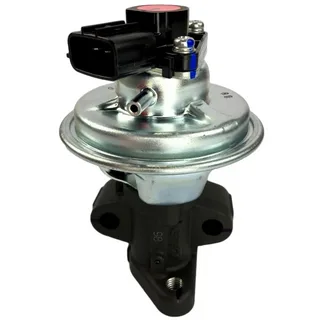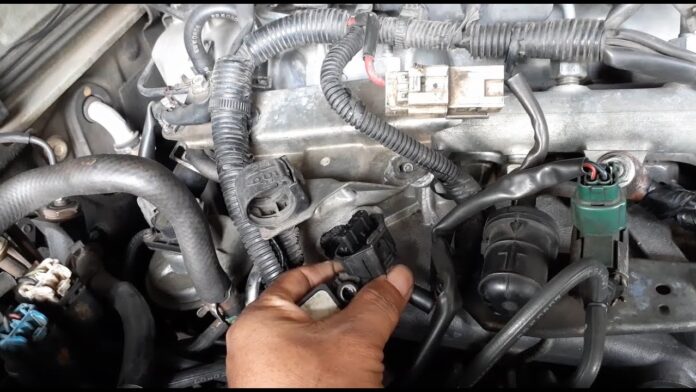When it comes to keeping your Ford Ranger running smoothly, there are many components that play a crucial role. One of these components is the Ford Ranger EGR valve, a key part of the vehicle’s exhaust system. The EGR valve is responsible for reducing emissions and improving fuel efficiency, making it an essential part of the engine’s functionality. Unfortunately, like any other mechanical part, the EGR valve can wear out over time and cause issues with your vehicle’s performance. In this blog post, we will dive into the importance of the Ford EGR valve, its function, and how to recognize when it needs to be replaced in order to keep your ride in top condition.
Understanding the P4-AT EGR
The P4-AT EGR system, specifically designed for the Ford Ranger, is a critical component in managing the truck’s emissions and ensuring optimal engine performance. This system is engineered to recirculate a portion of the exhaust gases back into the combustion chamber, effectively lowering combustion temperatures and consequently reducing nitrogen oxide (NOx) emissions. The EGR designation refers to the particular model and configuration tailored for the Ford Ranger’s engine, optimizing its efficiency and compatibility.
In operation, the EGR system opens and closes the EGR valve based on engine conditions, such as load, speed, and temperature, to precisely control the flow of recirculated exhaust gases. This precise control is essential for maintaining the delicate balance between reducing emissions and ensuring the engine runs smoothly without compromising performance. The system’s design includes features that prevent the intake of excessive exhaust gases, which could potentially lead to engine inefficiency or damage.
The EGR’s significance extends beyond emissions control; it also plays a part in enhancing fuel efficiency. By lowering combustion temperatures, it helps in preventing the engine from running too hot, which, in turn, can improve fuel consumption rates. This is particularly beneficial in heavy-use scenarios typical of Ford Rangers, such as towing and carrying heavy loads.
Common Symptoms of a Failing Ford Focus Rocker Cover
Identifying the early warning signs of a failing Ford Focus rocker cover is key to preventing more serious engine problems. A compromised rocker cover, which seals the top of the engine and contains the valve mechanism, can lead to a variety of issues that affect the vehicle’s performance and efficiency. One of the most noticeable symptoms is an oil leak. If you observe oil pooling under your vehicle or notice a greasy buildup around the engine, it’s possible your rocker cover gasket has deteriorated and is allowing oil to escape.
Another telltale sign is engine misfiring or poor performance. A damaged rocker cover can compromise the seal, leading to a loss of internal pressure. This can affect the engine’s combustion process, resulting in uneven running, a noticeable decrease in power, or even stalling. Unusual noises from the engine compartment, such as tapping or clicking sounds, could also indicate that the rocker cover or its components are not functioning correctly, potentially due to loose or damaged parts.
Lastly, if you detect a burning oil smell, especially when the engine is hot, it could be due to oil leaking from the rocker cover onto the exhaust manifold. This not only indicates a problem with the rocker cover but also poses a potential fire risk if not addressed promptly. Being vigilant about these symptoms and acting quickly can save you from more expensive repairs down the line.
Diagnosing Issues with Your Ford EGR Valve
Identifying problems with the Ford EGR valve begins with a thorough examination for any signs of physical damage or obstructions, which might hinder its function. Often, complications within the EGR system might not be readily apparent upon a simple visual check. This necessitates employing a more technologically driven approach, such as utilizing a diagnostic scan tool. This tool becomes invaluable as it can efficiently read and interpret any error codes related to the EGR valve that are stored within the vehicle’s onboard computer system. These codes can provide precise insights into the nature of the issue at hand, guiding further action.
Further diagnosis may require manual testing of the valve’s operation and the integrity of its components. This step is crucial for isolating specific faults, such as issues with the valve’s opening and closing mechanism or problems with the sensor that regulates the flow of exhaust gases. Such manual checks can reveal subtleties in performance deficits that aren’t immediately obvious.
For vehicle owners who may not possess the technical expertise or the necessary tools for these diagnostic procedures, enlisting the services of a qualified mechanic is strongly recommended. A professional can conduct these diagnostics with greater accuracy and also offer the appropriate repairs or recommendations based on the findings. It’s important to address any EGR valve issues promptly, as delaying can lead to more significant engine problems, affecting overall vehicle performance and emissions compliance.
Maintenance Tips for Your EGR Valve
To safeguard the longevity and efficiency of your Ford Ranger’s EGR Valve, establishing a routine maintenance schedule is paramount. This not only averts potential failure but also maintains your vehicle’s emission standards. Start by periodically inspecting the EGR valve for signs of wear or damage. Look out for any visible cracks or excessive carbon deposits, which can impede its operation.
Cleaning the valve is an essential preventative measure. Over time, carbon build-up can obstruct the valve’s function, leading to decreased engine performance and increased emissions. Utilize a specialized EGR valve cleaner, following the manufacturer’s instructions carefully to avoid damaging the valve. Remember, while cleaning can often restore function, it’s not a cure-all for every issue.
 Additionally, ensure that the surrounding components and connections are in good condition. Check hoses and gaskets for signs of deterioration or leaks, as these can affect the EGR system’s efficiency. Replacing these components when necessary can prevent more significant issues down the line.
Additionally, ensure that the surrounding components and connections are in good condition. Check hoses and gaskets for signs of deterioration or leaks, as these can affect the EGR system’s efficiency. Replacing these components when necessary can prevent more significant issues down the line.
It’s also beneficial to adhere to the service intervals recommended in your Ford Ranger’s owner’s manual. These intervals are designed to ensure all parts of your vehicle, including the EGR valve, are checked and serviced regularly to avoid unforeseen failures.
Lastly, maintaining a record of all maintenance activities can provide valuable insight into the health of your EGR system over time. This documentation can help identify recurring issues or predict when the valve might require cleaning or replacement, ensuring that your Ford Ranger remains both efficient and compliant with emission standards.
Step-by-Step Guide to Replacing Your Ford EGR Valve
Replacing the EGR valve in your Ford Ranger can seem like a daunting task, but with the right tools and guidance, it’s a manageable DIY project. Begin by ensuring the vehicle is parked on a level surface and that you have disconnected the battery to prevent any electrical accidents. With safety glasses on, locate the EGR valve on your engine; it’s typically found near the intake manifold.
The next step involves removing any components that might obstruct access to the EGR valve, such as the air intake system. With clear access, use a wrench or socket set to detach the bolts or nuts securing the EGR valve to its position. Note that some models might have a metal gasket between the valve and the engine or pipe it attaches to; handle this with care to avoid damage.
After removing the old EGR valve, it’s crucial to clean the mounting surface on the engine thoroughly. Any debris or gasket material left behind could prevent a proper seal, leading to leaks. If your new EGR valve comes with a new gasket, ensure it’s positioned correctly before mounting the valve. Reattach the valve with the bolts or nuts, tightening them to the manufacturer’s specified torque settings to avoid over-tightening, which could damage the valve or engine.
Reassemble any components you had to remove to gain access to the EGR valve, ensuring everything is securely fastened. Reconnect the battery, and start the engine to verify the installation was successful and the engine runs smoothly. Remember, tackling this task requires patience and attention to detail. If any step seems too complex or if you encounter unexpected issues, seeking professional help is advisable to avoid damaging your vehicle.
Choosing the Right EGR Valve for Your Ford Ranger
Selecting the appropriate EGR valve for your Ford Ranger is a decision that should not be taken lightly. While OEM parts are often the go-to choice for their assured compatibility and reliability, the market also offers a variety of high-quality aftermarket options that can provide equivalent or superior performance.
When navigating this choice, the primary focus should be on ensuring the part meets the specific requirements of your vehicle’s make, model, and year. This ensures that the new EGR valve will integrate seamlessly with your vehicle’s existing systems, avoiding any potential issues related to fit or functionality.
It’s advisable to conduct thorough research or seek advice from automotive professionals who can offer insights based on their experience with similar vehicles. Reading product reviews and comparing specifications can also be incredibly helpful in making an informed decision. Additionally, consider the warranty offered with the EGR valve, as this can provide an added layer of assurance regarding the part’s quality and durability.
FAQS
Q: Can I clean my EGR valve to avoid replacing it?
A: Cleaning the EGR valve is a viable option for restoring its function in many instances, particularly if the issue is due to carbon build-up. It’s important to note, though, that effectiveness depends on the severity of the clog or damage. Regular cleaning can help extend the life of the valve but won’t always negate the need for eventual replacement.
Q: How often does the EGR valve need to be replaced?
A: The frequency of EGR valve replacement varies based on several factors, such as the vehicle’s usage, overall maintenance routine, and environmental conditions it’s exposed to. While there’s no universal timeline for replacement, staying vigilant about its performance and condition is crucial. Conducting regular inspections and responding to any signs of malfunction early can prevent more significant issues.
Q: Could a faulty EGR valve cause my vehicle to fail an emissions test?
A: Yes, a malfunctioning or failed EGR valve can lead to increased nitrogen oxide (NOx) emissions, causing your vehicle to not meet the required emission standards during a smog test. Addressing any EGR valve issues promptly is essential for passing emissions tests and for contributing to cleaner air.
Q: Is it better to choose OEM or aftermarket EGR valves?
A: Both OEM and high-quality aftermarket EGR valves can be suitable choices. The key is ensuring the chosen EGR valve is compatible with your Ford Ranger’s specifications. While OEM parts guarantee a direct fit, some aftermarket options may offer comparable quality at a lower price point. Consulting with a trusted mechanic or doing thorough research can help you make an informed decision.
Conclusion
Maintaining the health and functionality of the EGR valve in your Ford Ranger is integral to the vehicle’s performance and its ability to meet emission standards. Through this comprehensive guide, we’ve explored the pivotal role of the EGR valve, outlined the common signs of malfunction, and provided actionable advice on maintenance and replacement procedures. The EGR valve’s role in reducing NOx emissions and enhancing engine efficiency cannot be overstated. Keeping this component in optimal condition through regular checks and cleaning can prevent the myriad issues associated with its failure.
| Other Good Articles to Read |
| Skank Blogs |
| Unreal Blogs |
| Tba Blogs |
| All City Forums |
| Dany Blogs |
| Refuge Blogs |
| Key Forums |
| The Big Blog Theory |
| Joe Blogs |
| Blogs 4 Me |
| Blogs Emon |
| Related Business Listings |
| Contact Directory |
| Local Business Profiles |

